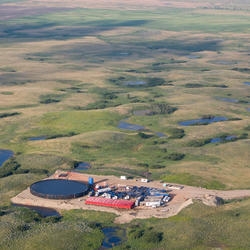Disinfection Byproducts from Treatment of Produced Waters
USGS Scientist Records Information
in Pennsylvania
Waters produced as a byproduct of oil and gas development were found to yield high concentrations of disinfection byproducts (DBPs) when treated. The U.S. Geological Survey (USGS) sampled stream waters upstream and downstream of the outfall of Publicly Owned Wastewater Treatment Works (POTWs), POTWs that receive and treat waters produced by conventional and unconventional oil and gas development, and commercial treatment plants that treat similar produced waters. The samples were analyzed for a range of DBPs and selected precursors. The study was designed to determine if produced waters resulted in elevated levels of DBPs in the streams to which the treated wastewaters were discharged.

The resulting data indicate that significantly higher concentrations of brominated DBPs are discharged in the effluents of commercial or publicly owned wastewater treatment plants that treat produced waters than POTWs that do not treat produced waters. The evidence strongly indicates that naturally high bromide levels in the produced waters react with other chemicals when the water is disinfected and these reactions form high levels of the brominated DBPs. This is the first time it has been shown that these activities contribute DBPs to streams where the wastewaters are discharged.
Of the hundreds of potential DBPs formed when water is disinfected the brominated forms have been shown to be among the most toxic. This study drew no distinction between produced waters from conventional oil and gas development techniques and unconventional oil and gas development techniques, such as hydraulic fracturing.
This study was funded by the USGS Toxic Substances Hydrology and Energy Resources Programs.
Related science listed below.
Energy Resources Life Cycle Integrated Science Team
Trace Levels of Organic Chemicals Limited to Local Reaches of a Stream near an Oil and Gas Wastewater Disposal Facility
USGS Scientist Receives Award for Assistance with National Wetlands Assessment
Examining Shifts in Stream Microbial Communities Exposed to Oil and Gas Wastewaters
Understanding Pathways of Unconventional Oil and Gas Produced Water Spills in the Environment
Iodinated Disinfection Byproducts found in Dairy-Impacted Wastewaters and Streams
Indication of Unconventional Oil and Gas Wastewaters Found in Local Surface Waters
Improvements in Wastewater Treatment Reduces Endocrine Disruption in Fish
National Reconnaissance of Pharmaceuticals, Hormones and Other Organic Wastewater Contaminants in U.S. Streams is Making an Impact
Related publications listed below.
Discharges of produced waters from oil and gas extraction via wastewater treatment plants are sources of disinfection by-products to receiving streams Discharges of produced waters from oil and gas extraction via wastewater treatment plants are sources of disinfection by-products to receiving streams
Waters produced as a byproduct of oil and gas development were found to yield high concentrations of disinfection byproducts (DBPs) when treated. The U.S. Geological Survey (USGS) sampled stream waters upstream and downstream of the outfall of Publicly Owned Wastewater Treatment Works (POTWs), POTWs that receive and treat waters produced by conventional and unconventional oil and gas development, and commercial treatment plants that treat similar produced waters. The samples were analyzed for a range of DBPs and selected precursors. The study was designed to determine if produced waters resulted in elevated levels of DBPs in the streams to which the treated wastewaters were discharged.

The resulting data indicate that significantly higher concentrations of brominated DBPs are discharged in the effluents of commercial or publicly owned wastewater treatment plants that treat produced waters than POTWs that do not treat produced waters. The evidence strongly indicates that naturally high bromide levels in the produced waters react with other chemicals when the water is disinfected and these reactions form high levels of the brominated DBPs. This is the first time it has been shown that these activities contribute DBPs to streams where the wastewaters are discharged.
Of the hundreds of potential DBPs formed when water is disinfected the brominated forms have been shown to be among the most toxic. This study drew no distinction between produced waters from conventional oil and gas development techniques and unconventional oil and gas development techniques, such as hydraulic fracturing.
This study was funded by the USGS Toxic Substances Hydrology and Energy Resources Programs.
Related science listed below.
Energy Resources Life Cycle Integrated Science Team
Trace Levels of Organic Chemicals Limited to Local Reaches of a Stream near an Oil and Gas Wastewater Disposal Facility
USGS Scientist Receives Award for Assistance with National Wetlands Assessment
Examining Shifts in Stream Microbial Communities Exposed to Oil and Gas Wastewaters
Understanding Pathways of Unconventional Oil and Gas Produced Water Spills in the Environment
Iodinated Disinfection Byproducts found in Dairy-Impacted Wastewaters and Streams
Indication of Unconventional Oil and Gas Wastewaters Found in Local Surface Waters
Improvements in Wastewater Treatment Reduces Endocrine Disruption in Fish
National Reconnaissance of Pharmaceuticals, Hormones and Other Organic Wastewater Contaminants in U.S. Streams is Making an Impact
Related publications listed below.









